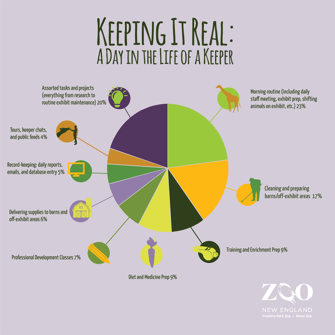
Photo by Jackie Ricciardi for Boston University
Keeper's Corner
We put our passion for wildlife to work at Zoo New England, and we carry that dedication outside Zoo gates. Here's just a small glimpse of some of our current and former keepers' commitment to all things wild.
Taking care of furry friends at Boston's Franklin Park Zoo; the broad responsibilities of a zookeeper
Giraffes, anteaters, and gorillas are just a few of Sarah Woodruff's coworkers in her role as a lead zookeeper at the Franklin Park Zoo. Watch WCVB Chronicle video.
Investing in nesting
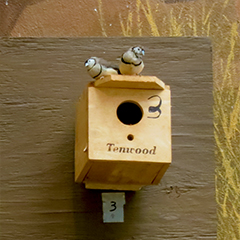 You’ve heard the phrase: “Where there’s a will, there’s a way,” but have you seen it in action? Zoo New England staff and volunteers display their extraordinary will to protect, preserve and improve the lives of animals on a daily basis. Visit our Bird’s World exhibit for a shining example of this dedication.
You’ve heard the phrase: “Where there’s a will, there’s a way,” but have you seen it in action? Zoo New England staff and volunteers display their extraordinary will to protect, preserve and improve the lives of animals on a daily basis. Visit our Bird’s World exhibit for a shining example of this dedication.
Thanks to the efforts of one such volunteer, Franklin Park Zoo’s Gouldian finches, budgerigars, kiwis and pygmy falcons have all received wooden nesting boxes handcrafted for their individual needs. Boxes provide cavity-nesting birds with shelter and a private spot to reproduce or tend to their young, so it’s important that birds feel comfortable in these spaces.
Working with staff, this Bird’s World volunteer creates each nesting box to exact specifications, literally down to the nuts and bolts. Certain materials are unfavorable or even toxic to some species, but fine to use  for others. There’s research and careful planning behind every nesting box created, which is why they can take weeks to complete. Be sure to check out our volunteer’s work, most easily seen in the Gouldian finch exhibit if you look along the left-hand wall.
for others. There’s research and careful planning behind every nesting box created, which is why they can take weeks to complete. Be sure to check out our volunteer’s work, most easily seen in the Gouldian finch exhibit if you look along the left-hand wall.
Build your own nesting box
Inspired by our nesting boxes? Build your own box and become a certified “NestWatcher,” assisting NestWatch --a nationwide nest-monitoring program-- in their efforts to learn more about the impact of environmental change on bird reproduction.
In the wild, nesting boxes can provide needed shelter and brooding space, due largely to habitat loss from increased development and removal of trees. Different design features target the habits and preferences of individual bird species and design plans are available for a wide range of nesting boxes including the chickadee PVC nest tube, tree swallow, eastern bluebird, small songbirds, owls, mourning dove, and American robin. The Cornell Lab of Ornithology is a treasure house of information about the birdhouse network and can provide specific information on species preferences.
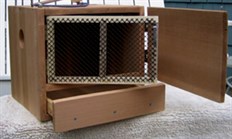 Here are the basic birdhouse guidelines and considerations: Use of natural untreated wood (pine, cedar or fir); walls at least ¾ inch thick for insulation; properly sized entrance hole and placed at the correct distance from the ground; and extended sloped roof and recessed floor with drainage holes to protect against heavy rain and ventilation holes to keep the interior cool. Also, to assist the fledglings’ exit, rough or grooved interior walls. (Sometimes an adult bird is unable to climb its way out and will get stuck in boxes because the inside walls are too smooth.) Caution: No outside perches that aid predators but do secure a predator guard at the bottom.
Here are the basic birdhouse guidelines and considerations: Use of natural untreated wood (pine, cedar or fir); walls at least ¾ inch thick for insulation; properly sized entrance hole and placed at the correct distance from the ground; and extended sloped roof and recessed floor with drainage holes to protect against heavy rain and ventilation holes to keep the interior cool. Also, to assist the fledglings’ exit, rough or grooved interior walls. (Sometimes an adult bird is unable to climb its way out and will get stuck in boxes because the inside walls are too smooth.) Caution: No outside perches that aid predators but do secure a predator guard at the bottom.
A nesting box should be monitored for activity, and once eggs are in place viewing times should be limited to less than a minute once a week.
Just for Kids!
Learn how to become a certified NestWatcher in our Kids' Corner!
Life as a zookeeper at Franklin Park Zoo
Meet zookeeper, Hannah Keklak, a zookeeper in Franklin Park Zoo's Children's Zoo and Franklin Farm. Hear from Hannah about an average day on the farm, and meet a few of her four-legged friends.
View BU Today's feature on Hannah: "Life’s a Zoo for CAS Alum: Hannah Keklak cares for a host of unusual animals at Franklin Park Zoo"
Video courtesy of BU Today, Boston University
Video produced by BU Today, Boston University
Producer and Editor: Jason Kimball
Production Associate: Amy Laskowski
Raising Amari, Franklin Park Zoo's giraffe calf
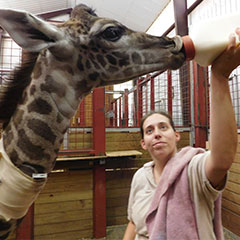 On July 24, 2016, Franklin Park Zoo celebrated the birth of a female Masai giraffe calf, Amari. It was, however, a rocky start for the new calf, whose medical issues at birth required specialized treatment. After a brief hospitalization at Cummings Veterinary Medical Center at Tufts University, it was determined that the calf’s best chance of survival would require hand-rearing by Franklin Park Zoo staff.
On July 24, 2016, Franklin Park Zoo celebrated the birth of a female Masai giraffe calf, Amari. It was, however, a rocky start for the new calf, whose medical issues at birth required specialized treatment. After a brief hospitalization at Cummings Veterinary Medical Center at Tufts University, it was determined that the calf’s best chance of survival would require hand-rearing by Franklin Park Zoo staff.
Caring for the calf required around the clock dedicated attention, coordination and teamwork by the Zoo’s skilled animal management and veterinary teams. Zookeepers arrived at the giraffe barn daily at 6:00 a.m. to prepare Amari’s bottles, which she was hand-fed three times a day. Staff continued to bottle feed Amari for another eight months until she was weaned.
Today, as a result of these tireless efforts, Amari is a thriving ambassador for her species. Learn more about Amari's journey in the video below and in our News section.
Sit. Stay. Save a cheetah.
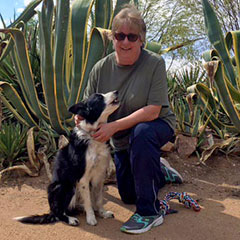 "We took [Finn] to a location where wild cheetahs were known to frequent and on his first day he found five scat samples – four of which we would not have found without him."
"We took [Finn] to a location where wild cheetahs were known to frequent and on his first day he found five scat samples – four of which we would not have found without him."
Assistant curator Chris Bartos spends her free time training dogs, but one of her pooches isn’t just winning agility competitions—he’s part of a global mission to save cheetahs in the wild. Bartos’ rescued border collie, Finn, is part of the Cheetah Conservation Fund's (CCF) cheetah census team, trained to sniff out cheetah scat (poop) in order to track the cats’ movements. Bartos traveled with Finn to Namibia, where she helped CCF staff learn how to work with the dog to search for and indicate scat. Scat location is recorded with a GPS device and then analyzed by geneticists to identify individual cats through DNA, examine diets, and track cheetahs’ range. Based on the results, CCF uses data regarding population size (which is steadily decreasing) and distribution to aid in conservation strategies. Read Bartos' full account (pdf), and learn more about Bartos and Finn's work in the video below.
Photo (zookeeper and cow): Jackie Ricciardi for Boston University

